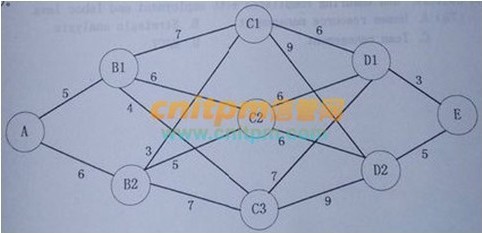( ) is the process of documenting, analyzing, tracing, prioritizing and agreeing on requirements and then controlling change and communicating to relevant stakeholders. It is a continuous process throughout a project.
A. Integrated management
B. Configuration management
C. Scope management
D. Requirements management
某厂编号为Ⅰ、Ⅱ、Ⅲ的三种产品分别经过A、B、C三种设备加工,已知生产各种产品每件所需的设备台时,各种设备的加工能力(台时)及每件产品的预期利润见表3
适当安排生产计划可获得最大总利润( )元
A、2000/3
B、2100/3
C、2200/3
D、2250/3
某部门有3个生产同类产品的工厂(产地),生产的产品由4个销售点(销地)出售,各工厂的生产量(单位:吨)、各销售点的销售量(单位:吨)以及各工厂到各销售点的单位运价(百元/吨)示于表4中。

适当安排调运方案,最小总运费为( )
A、450
B、455
C、460
D、465
下图中,从A到E的最短长度是( )(图中每条边旁的数字为该条边的长度)

A、17
B、18
C、19
D、20
( )is a collection of data sets, which is so large and complex that it becomes difficult to process using on-hand database management tools or traditional data processing applications.
A. Big data
B. Cluster
C. Parallel computing
D. Data warehouse
In requirements engineering, requirements elicitation is the practice of collecting the requirements of a system from users, customers and other stakeholders. In the following practices, ( ) is rarely used in requirements elicitation.
A. brain storming
B. interview
C. questionnaire
D. Monte Carlo analysis
Software configuration management (SCM) is the task of tracking and controlling changes in the software. Configuration management practices include configuration identification, change control, ( ) and configuration audit.
A. milestones marking
B. status reporting
C. stakeholder management
D. quality audit